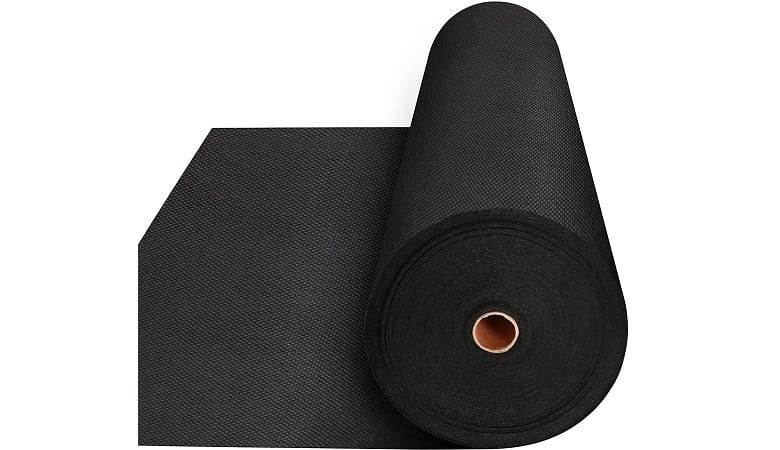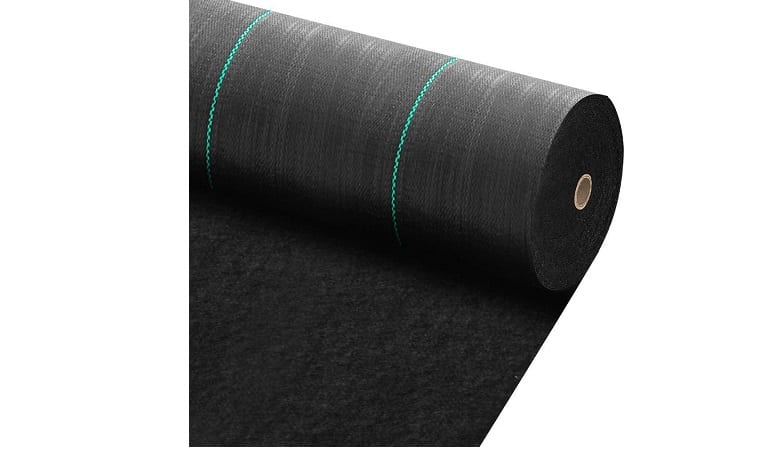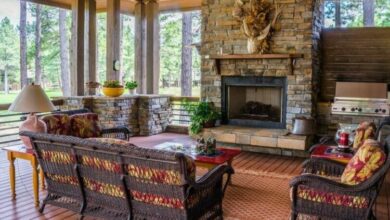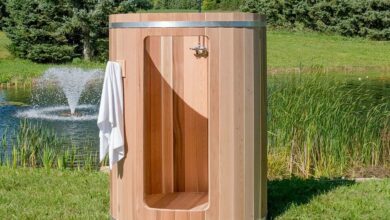
You’ve worked so hard on the garden that complements your fantastic, trim, green lawn, but it’s now threatened by unsightly sprouts that appear everywhere you look.
Weeds are a problem in your yard: bothersome, unsightly weeds.
Weed barriers are the solution. They do exactly what you’d expect: they act as a barrier between your beautiful garden or lush lawn and the sprouts of hideous weeds that keep trying to pop up and ruin the look.
Instead of constantly weeding, you can install one of these and relax. Weeds will not pass through.
We have selected the five best weed barrier products on the market after weighing their effectiveness, durability, cost, and every other factor. It is the cream of the crop, and it’s time to use them to protect your yard and garden.
- Best Weed Barrier – 2020 Reviews & Buying Guide
- Weed Barrier ECO Gardener Premium Pro
- Lawn Weed Barrier Control Fabric Goasis
- Premium Pro Garden Weed Barrier HOOPLE
- Garden Weed Landscaping Fabric AHG
- Amagabeli-Geotextile-Weed-Barrier
Eco Gardner Premium Pro WEED BARRIER Is The Best Overall.
ECO Gardener quickly took the top spot on our list for the best weed barrier under a rock. There’s a lot to like about them, so let’s start.
For one thing, you get a money-back guarantee. They care more about your satisfaction than anything else. It’s always reassuring to know you’re entering a transaction that will protect you if it doesn’t meet your expectations.
It’s called ECO Gardener because it’s designed to help your garden while also preventing weed growth, so you’re killing two birds with one stone. Your soil requires aeration and moisture to function correctly.
ECO Gardener created a thick mat with enough perforations to allow moisture to pass through and travel, so the soil does not become stale.
With three sizes to choose them, you can get all the coverage your yard requires without investing in another brand. There’s a 3ft x 50ft solution, a 3ft x 100ft mat, and even a 4ft x 50ft solution for garden beds that are further away from your home’s foundation/edge.
It quickly became one of the best-selling weed barriers on the market because it allows you to manage your garden independently. In addition, the mat is extremely lightweight and thick enough to keep weeds out for longer than competitors.
Weed mats will never be perfect. They will eventually break down and allow weeds to grow, but this is unavoidable.
You can only extend the time between installing weed barriers and when that occurs, and ECO Gardener gives you the most time to enjoy your garden.
However, nothing is perfect, and you should know that this fabric is resistant to weeds but not stress. When using it, take care not to walk on it. It tears easily; use caution when installing it, but once installed and covered, you’ll be fine.
- Heavy-duty is the type.
- Dimensions: 3ft x 50ft
- Installation is not included.
Goasis Lawn WEED BARRIER Ccontrol Fabric Runner Up

Goasis, the best weed barrier under mulch, includes some seriously fantastic features not found in other fabrics. As a result, the price will be higher, but given what they do to make these, the price is well worth it.
It includes a membrane made of nonwoven material, which means it was designed in-house and cut to size. It does come with a coating that may leach into the soil after a year or so of use, but that is common with most weed barriers.
Other sizes include 3ft x 300ft, 4ft x 100ft, 4ft x 300ft, and 5ft x 250ft. A Goasis weed barrier solution is available for any project size. Whether commercial or not.
The fabric is strong enough to blow the competition away, but it still has a long way to go before reaching ECO Gardener levels of effectiveness. However, there is a money-back guarantee if you are not satisfied.
It’s described as hassle-free, but no matter what you tell me, every weed barrier requires some effort to install.
Because it is a little bit heavier than most fabrics, it does lay down reasonably quickly, but wind gusts can still move it. Therefore, implementing this always becomes misaligned and must be adjusted along the way.
It’s critical to aerate your soil and allow moisture to pass through, which Goasis will do for you.
One significant advantage is that it is UV resistant, so if you lay it down and place gravel or rocks on top, any sunlight that peeks between those rocks will not quickly destroy the fabric.
- Nonwoven, heavy-duty type
- Dimensions: 3ft x 100ft
- Installation is not included.
Hoople Premium Pro Garden WEED BARRIER As An Alternative

HOOPLE is the way to go if you need something more durable than the thinner fabrics I’ve mentioned. They guarantee it for five years based solely on how well it is built.
One of the most significant issues with landscaping fabric is that it only lasts one to three years and must be replaced as the season’s change. The fact that HOOPLE is completely UV-treated contributes to its longer lifespan. It takes longer to degrade when exposed to UV rays, whether through soil light penetration or light around gravel/top layer products.
Air easily flows through it, and water soaks right down to the bottom of the soil—planting something in here and letting it grow naturally should be no problem.
The only significant issue here is that, as explained in our installation guide below, you must cut Xs in the fabric to place plants to grow through it effectively.
Because this fabric is thick, it’s easy to shred it rather than cut it evenly. Make sure you have a sharp knife or razor to pierce the material, or you’ll end up with a few weeds in the ruined areas.
Because of its thickness, this easily qualifies as the best weed barrier under gravel. Compared to their competitors, this is three times thicker than most landscaping fabric on the market.
As a result, it’s ideal for flower beds, mulching, and just about any other outdoor project you have planned. For longer distances from your home or project focus to the edge of your garden bed, HOOPLE offers a 32″ x 180ft roll or a 48″ x 180ft roll.
- Heavy-duty and ultra-thick
- Dimensions: 32″ x 180ft
- Installation is not included.
Ahg Gardner WEED Landscaping Fabric As An Alternative
Who wants to repeat this year after year?
Nobody. We’ve shown you excellent fabrics that provide 36-60 months of peace of mind, which AHG does. So if you lay this down, you won’t have to worry about weeds for a long time.
As the best weed barrier under a stone, you can dump your layer on top without worrying about accidentally destroying the fabric. But, of course, this is in the AHG premium series, which is their top-tier, so you pay a little more.
I want to debunk a myth: they market this as a 20-year premium fabric. I’ve seen 10-year-old sidewalks with weeds growing through the concrete, so I’m not going to put my life in the hands of Mother Nature for the next two decades.
Regardless, it’s potent and will keep weeds at bay for a long time, so don’t rule it out.
I’d use this for high-end commercial landscaping rather than just gardening. As previously stated, you must cut X shapes in landscaping fabric to effectively place plants; otherwise, the roots will not have a place to grow.
Because this fabric is intended to be a complete barrier, it is best suited for gravel driveways and office building landscaping rather than gardening.
You can still use it for gardening if you want; it makes the job a little more complicated. Because it’s made of polypropylene, it won’t degrade or leach into the soil for a long time. It is due to UV damage, as polypropylene (like most synthetic polymers) is sensitive to UV rays.
- Polypropylene, heavy-duty
- Dimensions: 3ft x 300ft
- Installation is not included.
Amagabeli GEOTEXTILE WEED BARRIER As An Alternative
Amagabeli did not produce the best weed barrier fabric on our list, but they cut, so kudos. It comes with a 300-foot roll with a 3-foot width, but the price is usually what turns people off.
I want to justify the price solely on how thick this fabric is and how well it prevents weeds from growing through it.
It quickly provides three to six years of weed protection (depending on the climate), and when the sides are arched, it acts as a perfect cover to protect against significant mud patches caused by heavy rainfall.
The main focus here is commercialization: you can put almost any cover on this, from gravel to rocks and more, and the fabric will not rip. You’d have to be trying hard to ruin this fabric.
Despite its high price, one key feature of Amagabeli’s Geotextile is that it is made of a nonwoven layer that protects against UV rays while remaining water permeable. Unfortunately, the more dense a fabric is, the more difficult it is to make it water passable.
While it is more resistant to UV rays than most weed barriers, it is not air permeable, so the soil beneath will not receive adequate aeration. Small punctures along the length of the roll could be used to fix this, but that defeats the purpose of blocking weeds.
So, what is the bottom line?
It’s worth the money, but it’s not ideal for gardening. I would use this for landscaping where only mulch, gravel, or rocks will be placed on top. If you want to use it for plants, they’ve installed green stripes on the underside of the fabric to show you the best places to plant them.
- Nonwoven, heavy-duty type
- Dimensions: 3ft x 300ft
- Installation is not included.
Weed Barrier Buying Guide and FAQ
How Do I Set Up A WEED BARRIER?
You’ve purchased the best landscape fabric, but you know it won’t install itself. We have your back. It is a quick and dirty guide to installing it.
1. Crumble The Ground
Remove excess grass with a hoe and trowel. Remove any remaining grass and weeds by hand, leaving as much soil as possible.
2. Time To End
Churn the soil with a tiller. There may be roots, weeds, and grass in the mix. After a full till, remove with your hands. If necessary, until one more time.
3. Flatten The Planet
Flatten the soil with your preferred tools. We want the fabric to be laid out evenly.
4. Play It Out
The fabric should be rolled out like a tube of wrapping paper. Even it out so the edges of your garden box or barrier line up.
5. Check The Weight
Landscaping staples are available and can be driven through fabric with the blunt end of a hammer. Place one of these every eight feet in the material to weigh and secure it.
6. X Defines The Spot
Once the fabric is secured, make X-shaped incisions in it. It is where you would plant new plants so they can get nutrition from the ground while also keeping weeds at bay. This step is optional, but it is recommended for gardeners.
7. Install Soil Or Mulch
Trim where necessary along the edges. Trim any small fences or barriers around the garden to meet that standard. Pour soil or mulch on the weed barrier landscaping fabric once the garden barrier is in place. Presto.
Can WEED BARRIERS Be Layed With ROCKS, GRAVEL, OR STONE?
They most certainly can. Some gardeners will add a layer of gravel or colorful rocks on top of weed barriers for aesthetic purposes. Some people use it to put up weed barriers in their gardens.
I mentioned landscaping staples earlier. However, I understand that this isn’t something everyone wants to use.
If you don’t want to use them, place the best landscape fabric beneath rocks and stones to weigh it down in the corners.
Remember that this will be less effective. If you lay your weed barrier down and use objects to weigh it down rather than secure it to the soil, you may encounter a few issues.
Misalignment
You lay down the weed barrier fabric in a specific pattern, but wind comes along and ruins the alignment because lightweight rocks weigh it down. Also, it can be aggravating if you place it flush with a small fence or up against the side of your foundation.
Temporary Solution
Even when placed on the corners of your weed barrier, you risk unintentionally curling the fabric and not effectively blocking weeds in your specific garden bed or box.
Securing the fabric offers a long-term solution. You don’t want to return to find the left half of your garden bed fabric fluttering in the wind if you have to run out and get more mulch (we all underestimate how much it takes).
Later Fabric Changes
The fabric is more resistant to weeds growing beneath it when it is secured with landscaping staples. There is more give with rocks, so weeds will have less resistance and can fight more effectively. However, it may cause them to pass through the fabric faster than expected.
Can You Use WEED BARRIERS On Your Own Without Covering Them?
Even the best commercial landscape fabric isn’t perfect, and weeds can grow through it if it isn’t weighted down with something.
Wind can pull the corners up, allowing seeds to germinate underneath if the weed barrier is not weighted down. Therefore, it does not serve as an effective barrier.
Many weed barrier fabrics allow light to pass through, allowing weeds to grow.
When you weigh it down with gravel, rocks, or even soil/mulch to plant a garden, you reduce sun exposure and make it more difficult for weeds to grow. That sunlight will be absorbed by everything produced above the fabric.
If you don’t cover it, weeds will come through sooner than expected.
In the meantime, if you aren’t covering it, I hope you’re using plenty of landscaping staples to keep it secure. It’s OK to leave it uncovered for a few weeks while you buy soil and plants, but I wouldn’t recommend it as a long-term solution.
Can You Walk Over To WEED Bars?
It is possible, but it is not advised. If you’re careful, you’ll only crumple up the top layer of the fabric, and that’ll be the end of it. On the other hand, you’ll tear through this fabric like a napkin if you’re not wearing boots with jagged grips on the bottom.
The best weed control landscape fabric isn’t advertised as being indestructible. In reality, it’s a thin fabric that you can hold up in front of you and still see a lot of light through. However, it must allow water to flow through it, or else you will drown your plants.
You should avoid walking on them because they are pretty fragile. If you’re in the process of installing them in your yard or garden, make sure you don’t walk across them.
It’s sometimes unavoidable, but if it is, remove your shoes before doing so to avoid overstressing the fabric.
Does It Affect Water Absorption Or The Leaching Of Chemical?
It slows but does not stop water absorption. So water will still flow through it to some extent, but the mud will not.
That is why landscaping fabric in the northern hemisphere is used beneath gravel and rocks in parking lots and commercial building landscaping. It collects mud and slush without letting it go, so it doesn’t detract from the area’s aesthetics.
When it comes to chemicals, however, I have some bad news. Chemicals can and frequently do leach from these fabrics. In addition, they aren’t meant to last forever, which is why manufacturers use chemical sprays and coatings to increase the durability of these fabrics.
Is it harmful to the environment?
Yes. Will it prevent your plants from growing on top of it?
No. If anything, the chemicals may make the soil sterile for weed growth.
Typically, UV light degrades these materials, but constant running water from gardening or rain is enough to start leaching chemicals as soon as 90 days after installation.
Creating a More Effective Weed Barrier
Other methods for keeping weeds at bay in your garden include:
- Tilling.
- Sifting soil to remove seeds.
- Pruning trees to prevent cross-germination.
But the most important thing you can do, the one that addresses all of those variables, is to install a weed barrier that does most of the work for you.
ALSO SEE:Stamped Concrete The Best Material To Pave Your Patio
If you want to finally relax and enjoy your lawn instead of worrying about all the little green goblins, it’s time to get on the right track and build a better barrier.




